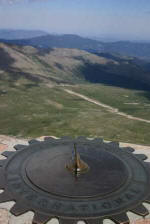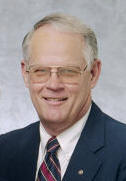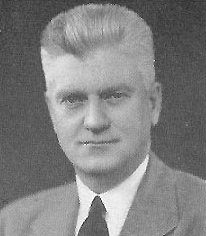
July 15, 2006 – High atop Mt. Evans at over 14,000 feet was
a celebration embracing beauty and history – from the
brilliant blue sun drenched sky (yet brisk 55 degrees) to
the sentiment, to the fellowship, but
mostly to the memories. I imagine the day was equally as
delightful 65 years ago when the
Plaque for
Peace was placed by Denver Rotarians atop Mt. Evans. This
gorgeous day in July was spearheaded by
Mountain Foothills Rotarian Wil Swart, to re-dedicate the
monument, to bring about a new awareness,
and bring together Rotarians to enjoy its greatness. And
that he did!
Rotarians from all over Colorado gathered to hear Mr.
Swart’s remarks
along with Past District Governor (PDG), Norris Hermsmeyer’s
rededication,
and the music accompaniment of “The Original Cow Boy
Band*.” Particular mention of a special attendee on this
day, revered
Rotarian, PDG Loy Dickinson, along with a family that he has
been
hosting from Czechoslovakia. A family that assisted him when
his plane
went down during WWII – one can only imagine the impact and
memories this day presented for all of them.
 Past District Governor Norris Hermsmeyer’s remarks were
appropriately monumental in scope and are reprinted below
for your
enjoyment. A special thanks to Wil Swart for his efforts in
bringing this
important piece of Rotary Global History to our attention.
Past District Governor Norris Hermsmeyer’s remarks were
appropriately monumental in scope and are reprinted below
for your
enjoyment. A special thanks to Wil Swart for his efforts in
bringing this
important piece of Rotary Global History to our attention.
PDG Norris Hermsmeyer’s remarks:
“Many of the comments here
today come from the book, “A
Century of Service,” by Daniel C. Forward, a book created to
mark Rotary’s 100th anniversary. Other
parts of these comments came from articles posted on the
Rotary 100 history website.
“One of the things that appeals to me about Rotary is how it
continues to evolve. Founded in 1905, the case
might be made that it was a club for one guy to get known in
his community and looking for a fellowship of
professional men. The case could also be made that Rotary
was to be a “leads” club, men of different
professions dealing with each other based on a mutual
respect and common business ethic.
“Shortly after the organizations founding, a new focus was
found, that of serving the community as
volunteers in ways that were appropriate for and to that
community. Rotary’s motto then as it is today, is
“Service Above Self.”
“Peace was certainly not considered to be a role for Rotary
in the early
organizational days.
“During the period of 1912 through World War 1, the idea
that Rotary was
or might be a medium for the promotion of international
peace and good
will was voiced many times by many clubs and individual
Rotarians
around the world. Many of these same individuals and clubs
would take
action as they saw fit within their own groups.
“In 1920, when Rotary International met in Atlanta, the idea
that peace
and good will might become a standard of Rotary was first
expressed. In 1921, Rotary met in Edinburgh,
Scotland. Many of the 2523 attendees had lost friends and
family in the WWI conflict. They were weary
witnesses to the need for world Peace.
“Just 16 years after Rotary began, it became an organization
with the worthy objective to “aid in the
advancement of international peace and goodwill through a
fellowship of business and professional men (and
now women) of all nations united in the Rotary ideal of
service.”
“Rotary has approached peacemaking systematically—it has
sought to breakdown the barriers that cause
people to point fingers at one another. By trying to
understand people’s points of view and reaching across
lines of race, religion and culture to become partners in
service to all mankind, tensions are reduced and
friendships increased. Humanitarian aid has been Rotary’s
answer to hunger, sickness, illiteracy and
economic disaster, the seeds of conflict.
“Over the years, RI Boards and clubs have laid out policies
and programs of how Rotarians can contribute
to the peacemaking role.
“President Warren G. Harding (a Rotarian until his election
to office) in 1923 said, “If I could plant Rotary
in every community in the world, I would do it, and then I
would guarantee the tranquility and forward march
of the world.”
“One of the initiatives in the period between WWI and WWII
was the creation of the Waterton-Glacier
International Peace Park on the border between the U.S. and
Canada.
“The Rotary Peace marker in this park at the point where the
Continental Divide in the U.S. meets the point
marking the origin of the Continental Divide in Canada is
significant to us today for two reasons.
 – A prime motivator of that memorial was
Thomas Davis, the
RI President from Butte, Montana who
would serve in 1940-41. We shall hear more about him in a
minute.
– A prime motivator of that memorial was
Thomas Davis, the
RI President from Butte, Montana who
would serve in 1940-41. We shall hear more about him in a
minute.
– One of the ongoing projects of this District of Rotary,
spearheaded by PDG Mat Matson of Conifer
Rotary is the development and maintenance of the Continental
Divide Trail running 3100 miles from
Canada to Mexico. Indeed it is his hope to create a Peace
Memorial marker at the end of the
Continental Divide when it meets the Mexican border. It may
be a little difficult to define that point
given the relative flat land of New Mexico at that point.
“With the “Winds of War” again threatening, the RI
convention in 1940 was held in Havana, Cuba. The
3700 delegates to that gathering adopted a resolution
calling for “freedom, justice, truth, sanctity of the
pledged word and respect for human rights.” Fast forward to
1948 when the newly chartered United Nations
wrote the Universal Declaration of Human Rights, based on
the framework of this same RI resolution
adopted in 1940.
“The 1941 Rotary convention was in Denver with 8900 in
attendance, 90% of the Rotarians from the U.S.
and the balance from other parts of the Western Hemisphere.
The dilemma was that many Rotarians around
the world were at war, or soon would be.
“The Peace Memorial we see before us today was to have been
dedicated by the 1940-41 RI President
Armando de Arruda Pereira of Sao Paulo, Brazil, but
inclement weather made the dedication impossible.
“Perhaps, fortuitously, the RI President who would serve for
the Rotary year 1941-42, Thomas Davis
(remember him from the Peace Memorial on the Canadian
border) of Butte, Montana was able to return to
Colorado for the formal dedication.
The Event was carefully
monitored by the natives
“In his address to the Denver convention, President David
knowing what
was facing the world stated, “You and I know Rotary’s
limitations—but
we also know its capacities. We know we can do something.
With a
world full of reasons for pessimism, I am not pessimistic.
For my faith in
the ultimate triumph of goodness and kindliness is as deep
as my faith in
a power infinitely greater than man’s. Yet in that faith I
find no excuse,
no reason for resignation.”
“It is not surprising that the theme for RI President
Davis’s year was
“Peace will Come.” We know Rotarians worldwide worked toward
that
end, just as following the war so many Rotarians were
instrumental in the creation of the United Nations,
an organization dedicated to bringing men and countries
together to end peace and strife in the world.
“Before you, you see a memorial built of active rock, part
of a wall, at an elevation of over fourteen thousand
feet with a mountain view finder. The finder or finger is of
bronze placed on a circular plate of bronze 14
˝ inches in diameter. The finger is moveable upon the
circular plate upon which radiates lines to identify
mountains and other points of interest.
 “Below that are certain inscriptions denoting Rotary’s
objectives, including the one passed at the 1921
Rotary International Convention identifying the “advancement
of international understanding, good will and
peace through a fellowship of business and professional mean
called in the ideal of service.”
“Below that are certain inscriptions denoting Rotary’s
objectives, including the one passed at the 1921
Rotary International Convention identifying the “advancement
of international understanding, good will and
peace through a fellowship of business and professional mean
called in the ideal of service.”

